Phobia Statistics, Facts, Types, Symptoms, Demographics, By Country, Region
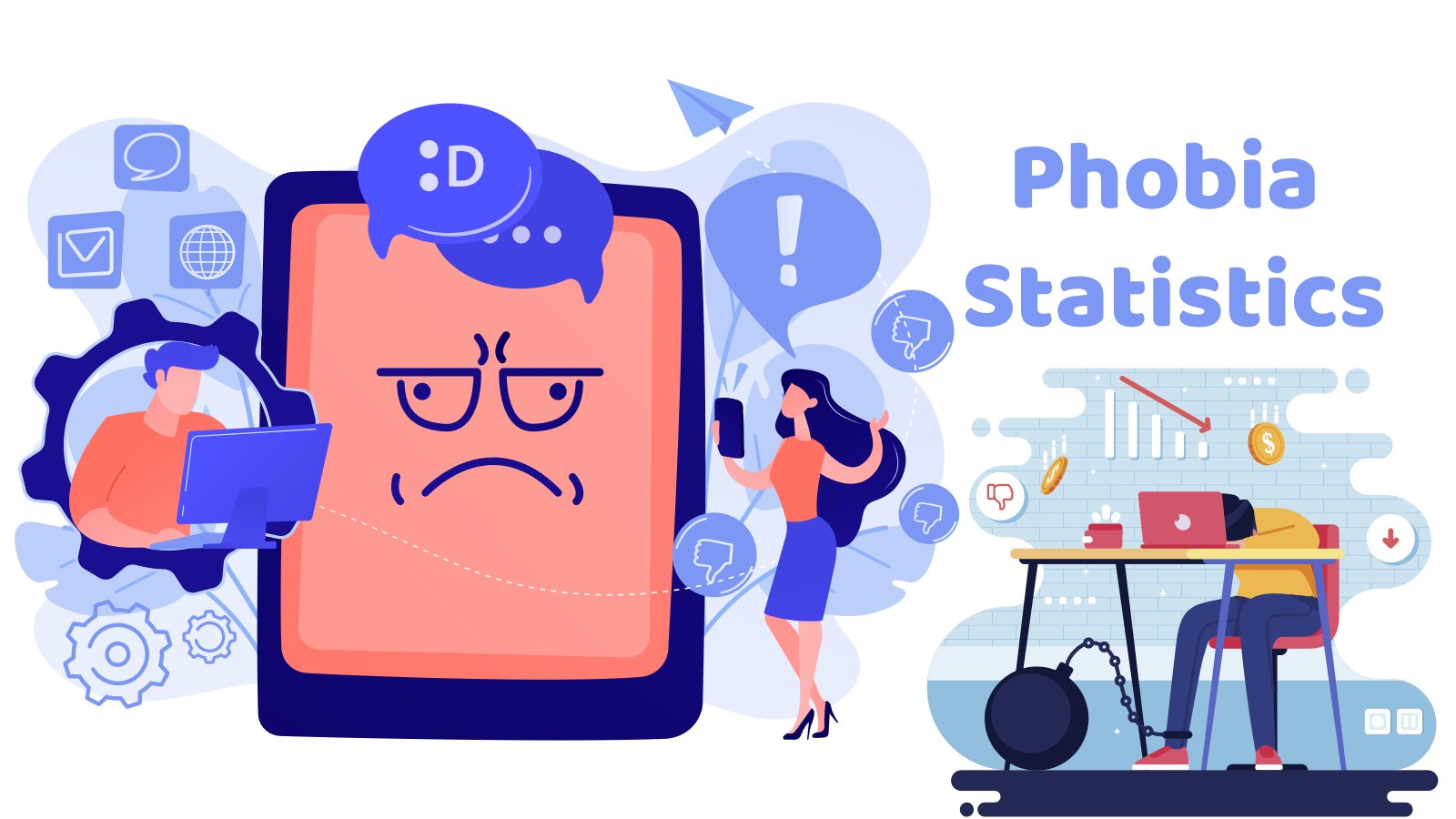
Page Contents
Introduction
Phobia Statistics: Living with the fear of something, just like Ron in Harry Potter was afraid of spiders is what phobia is. There are thousands of phobia types, and millions of people around the world are suffering from the disorder. The most common phobia is fear of animals and closed-in spaces. There is no actual prevention of such disorders, but they are treatable.
These Phobia Statistics are written in a way to understand the current situation around the world, with well-researched and recent insights from the United States of America. If you are one of the individuals who have any type of phobia, don’t get scared, it’s okay to talk about it!
Editor’s choice
- 40% of the people suffering from Agoraphobia are suffering from severe issues.
- In the United States of America, the highest number of people have a fear of animals resulting in 40%.
- As a result of COVID-19, and following cases of Russia and Ukraine, in the month of July 2022, there were 63% of the people globally, had a fear of relative recession.
- 15 million Americans are suffering from social phobia, resulting in 7.1% of adults and 5.5% of teenagers.
- 7% of the worldwide population is suffering from panic disorder, 1.6% of these are male and 3.8% are female.
- According to Phobia Statistics, there are 31.9% of adolescents aged between 13 to 18 years suffer from anxiety disorders.
- Women are 2 times more likely to suffer from any specific phobias than men.
- Specific phobias have affected 9.1% of Americans resulting in 19 million of the population.
- Patients with anxiety disorder are 3 to 5 times more likely to go for a doctor’s visit, while patients with psychiatric disorders are 6 times more likely to be hospitalized for a similar problem.
- Around the world, 3.6% of the population is suffering from post-traumatic stress disorder, out of these 1.8% are men and 5.2% are women
What is Phobia?
A phobia is a type of anxiety disorder that triggers physical or emotional reactions toward any place, object, or situation. Phobias have a prevalence rate of more than 6 months and can severely impact the individual. There are multiple types of phobias around the world. Phobias are treatable with exposure therapy, meaning, that the individual is presented with the situation to overcome the fear. Other types of phobias such as social or agoraphobia are treatable with medications or counseling. The frequency of specific and social phobias is 5% and agoraphobia has a 2% of frequency rate.
Facts on Phobias
- The Amygdala, the part of the brain is responsible for triggering specific phobias.
- Specific phobias can prevail throughout life.
- Social phobias are culturally related and mostly affect all types of ethnic people.
Types of Phobia (Top 10 Common Phobias around the World)
- Social anxiety – fear of being watched or humiliated. It can develop at a young age and if not treated well, it can last throughout life.
- Agoraphobia– The fear of being alone in a place or situation, considering the escape difficult. These people love to stay at home.
- Mysophobia – These people are engaged in the extreme level of cleaning and keep washing their hands, and don’t go to events where they think they might get dirty.
- Trypanophobia – This is a fear of injections. In the United States of America, it has been estimated that around 20% to 30% of adults are suffering from it. People with this phobia experience an extreme level of dread and increased heart rate during the procedure.
- Astraphobia– These people are scared of lightning and thunder. They may start shaking and experience increased heartbeat during the lightning and thunder.
- Cynophobia– These people experience a fear of dogs. This type of phobia occurs because of past experiences of dog biting.
- Aerophobia– In the United States of America, around 10% to 40% of adults feel this type of phobia. During the process, they may feel disoriented and can experience increased heartbeat and trembling. These people avoid flying.
- Arachnophobia– This is a fear of spiders.
- Acrophobia – This refers to the fear of heights and occurs in 6% of people. These people avoid going to tall buildings, bridges, and towers.
- Ophidiophobia– This is a fear of snakes.
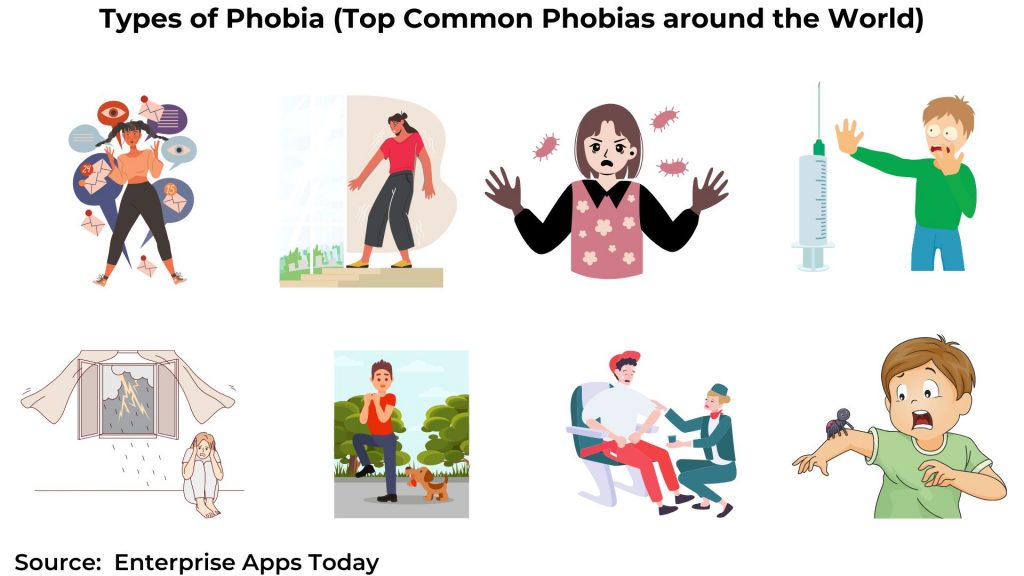
Reasons for Phobia
- Uncertain changes in brain function are linked to the development of specific phobias.
- Past negative, or traumatic experiences in life.
- Phobias can be developed due to genetics or learned behavior.
- Long-term stress.
- Childhood events play an important role in developing specific phobias.
Symptoms of Phobia
Psychological
- Anxiety or panic attacks.
- A feeling of dissociation, being detached from the body.
- Fear of dying.
- Fear of fainting.
- Fear of losing control.
- Stress
- Depression
- Recurring embarrassment.
- A loss of control.
Physical
- Vomiting or Nausea.
- Shaking or Trembling.
- Tingling or numbness sensations in the body.
- Tightness in the chest or frequent chest pain.
- A feeling of choking.
- Increased heart rate.
- Sweating.
- Reduced or shortened breaths.
General Phobia Statistics
- According to Phobia Statistics, Anxiety disorders or phobia is the most common mental illness found in the United States of America.
- These types of disorders are treatable but only 36.9% of the people have received treatment for them.
- Patients with anxiety disorder are 3 to 5 times more likely to go for a doctor’s visit, while patients with psychiatric disorders are 6 times more likely to be hospitalized for a similar problem.
- As a result of COVID-19, and following cases of Russia and Ukraine, in the month of July 2022, there were 63% of the people globally, had a fear of relative recession.
- In the United Kingdom, at least one person is suffering from some kind of phobia resulting in 10 million.
Phobia Statistics by Types
- According to Phobia Statistics, Agoraphobia is a rare type of Phobia that has affected only 0.9% of Americans resulting in 1.8 million people.
- Agoraphobia is observed commonly at the average age of 20 years.
- The prevalence rate of Agoraphobia in teenagers is 2.4% aged between 13 to 18 years.
- 40% of the people suffering from Agoraphobia are suffering from severe issues.
- On the other hand, Specific phobias usually occur at the age of 7.
- Specific phobias have affected 9.1% of Americans resulting in 19 million of the population.
- The prevalence rate of specific phobias is higher in teenagers resulting in 15.1%.
- Women are 2 times more likely to suffer from any specific phobias than men.
- The most commonly found types of specific phobias are fear of closed-in places, dogs, flying, highway driving, tunnels, animals, thunder, injuries causing blood injuries, heights, medical and dental procedures, water, etc…
- Moreover, Phobia Statistics state that, 30% of social anxiety disorder cases are severe.
- 15 million Americans are suffering from social phobia, resulting in 7.1% of adults and 5.5% of teenagers.
- In the United States of America, only 40% of social phobia cases receive treatment.
- Whereas above 1/3 of the population with social phobia wait for 10 years or more to receive treatment.
- Social phobia is usually observed at the age of 13 years.
- The prevalence rate of social anxiety is almost similar in men and women.
- 5% of the residents in the United States of America experience a specific phobia at some point in their life.
- 3% of adults in the United States of America, avoided going to dentists due to Dentophobia.
- Dentophobia is more likely found in females than males.
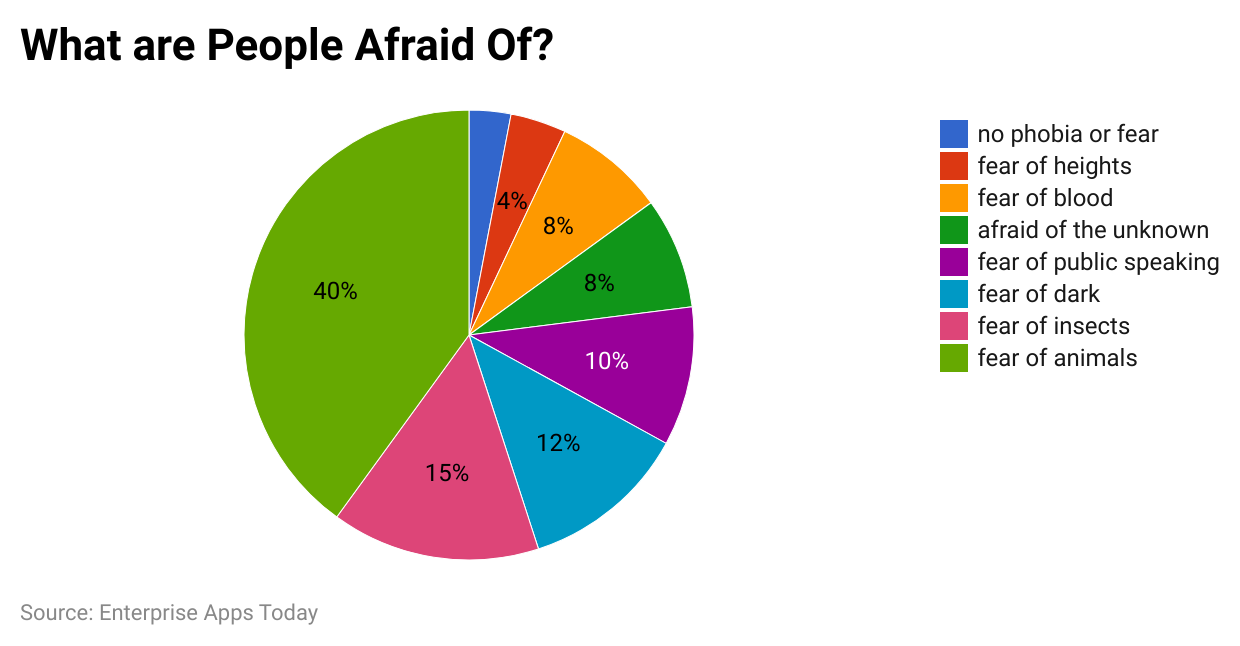
(Source: fearaz.com)
- In the United States of America, the highest number of people have a fear of animals resulting in 40%.
- Whereas 15% of the population is afraid of insects, and 12% of people are afraid of darkness.
- 10% of the people are living with a fear of public speaking and 8% are afraid of the unknown.
- Similarly, 8% of the people in the United States of America, are living with a fear of blood.
- As stated by Phobia Statistics, there are 4% of people suffer from a fear of heights.
- On the other hand, 3% of the people have no phobia or fear.
What were Americans afraid of in 2022?
- As of 2022, Phobia Statistics of the United States of America state that, one of the top three reasons for fear in Americans is corrupt government officials resulting in 62.1%.
- Other top two reasons for fear mentioned are people every individual love becoming seriously ill and Russia using nuclear weapons resulting respectively in 60.2% and 59.6%.
- Other fears stated by Americans in 2022 were – dying of people they love (58.1%), The US being involved in another world war (56%), not having enough money for the future (53.7%), Economic/ financial collapse (53.7%), pollution of oceans, rivers, and lakes (52.5%) and biological warfare (51.5%).
| Top 10 Fears of 2022 | % of Very Afraid or Afraid |
|---|---|
| 1. Corrupt Government Officials | 62.1 |
| 2. People I love becoming seriously ill | 60.2 |
| 3. Russia using nuclear weapons | 59.6 |
| 4. People I love dying | 58.1 |
| The U.S. becoming involved in another world war | 56 |
| Pollution of drinking water | 54.5 |
| Not having enough money for the future | 53.7 |
| Economic/financial collapse | 53.7 |
| Pollution of oceans, rivers, and lakes | 52.5 |
| Biological warfare | 51.5 |
(Source: blogs.chapman.edu)
Phobia Statistics by Demographics
- According to Phobia Statistics, there are 31.9% of adolescents aged between 13 to 18 years suffer from anxiety disorders.
By ethnicity
How many people experience panic disorder?
- 1% of Hispanic Americans and 2.1% of Asian Americans suffer from panic disorder.
- Similarly, there are 3.8% of African Americans and 5.1% of white Americans experience panic disorder.
What percentage of people have generalized anxiety disorder (GAD)?
- According to Phobia Statistics, there are 2.4% of the Asian population suffers from a generalized anxiety disorder.
- While 4.9% of African Americans and 5.8% of Hispanics struggle with similar issues.
- And there are 8.6% of white Americans with a similar problem.
How many people experience social anxiety disorder?
- As of today, 12.6% of the white ethnic background people are experiencing a social anxiety disorder.
- Furthermore, Phobia Statistics state that, 8.6% of African people and 5.3% of Asian people feel the same.
- There are 8.2% of Hispanic Americans suffer from a social anxiety disorder.
Prevalence of PTSD
- Moreover, there are 6.5% of white Americans, and 8.6% of African Americans suffer from PTSD.
- While 1.6% is the prevalence rate of PTSD in Asian Americans.
- There are 5.6% of Hispanic Americans suffer from a similar situation.
By Types
- Around the world, 3.6% of the population is suffering from post-traumatic stress disorder, out of these 1.8% are men and 5.2% are women.
- Furthermore, Phobia Statistics state that, specific phobias are a common type of anxiety disorder, having 9.1% of the population suffering, out of which 12.2% are women and 5.8% are men.
- 7% of the worldwide population is suffering from panic disorder, 1.6% of these are male and 3.8% are female.
- Furthermore, social anxiety disorder has affected 7.1% of the global population, 6.1% of men, and 8% of women are suffering from it.
- Obsessive-compulsive Disorder (OCD) has a prevalence rate of 1.2% around the world. Out of these, 1.8% affected are women, and 0.5% are men.
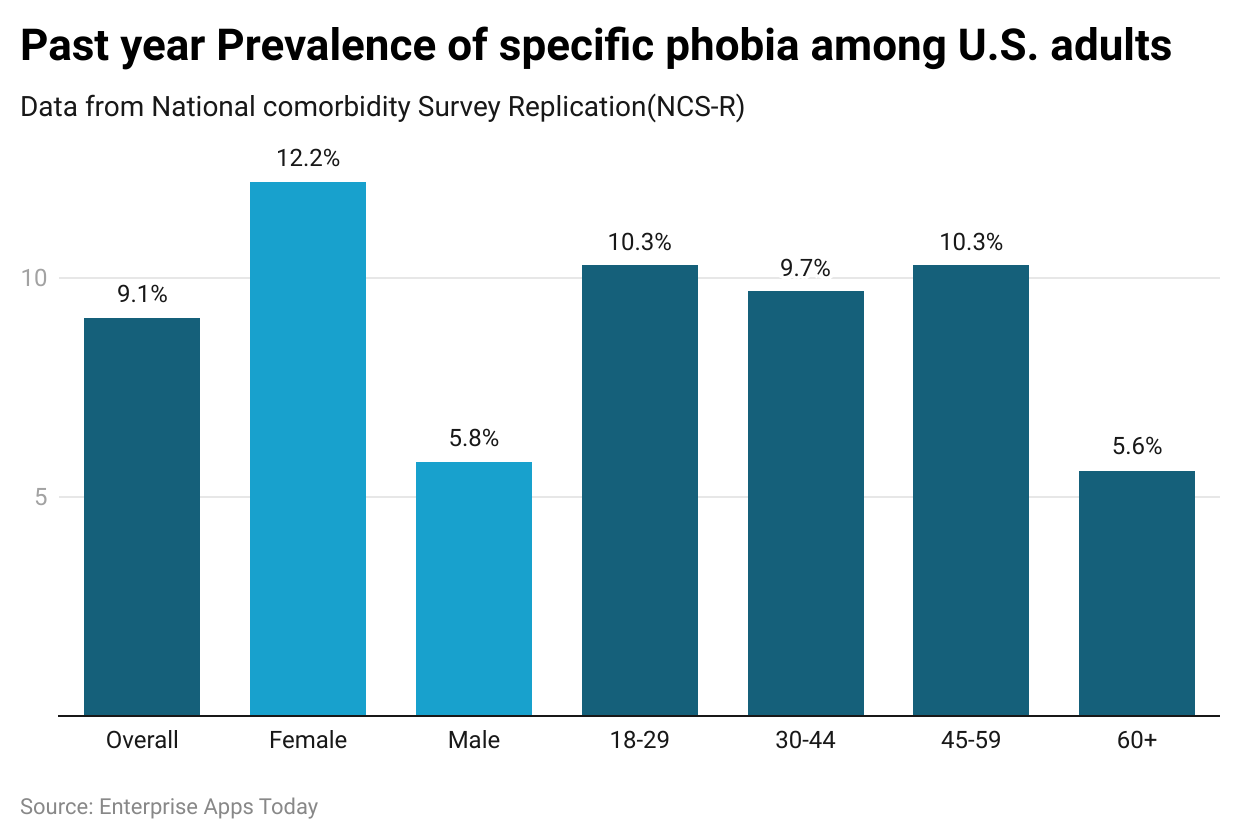
(Source: nimh.nih.gov)
- The overall last year prevalence rate of specific phobia among adult Americans is 9.1% out of this 12.2% are female and only 5.8% are male.
- Adults aged between 18 to 29 years have a rate of 10.3%, whereas it is 9.7% for people aged between 30 to 44 years.
- Further Phobia statistics state that in the previous year, there were 10.3% of Americans aged between 45 years to 59 years suffered from a specific phobia, while 5.6% of the adults belonged to the 60 years and above age group.
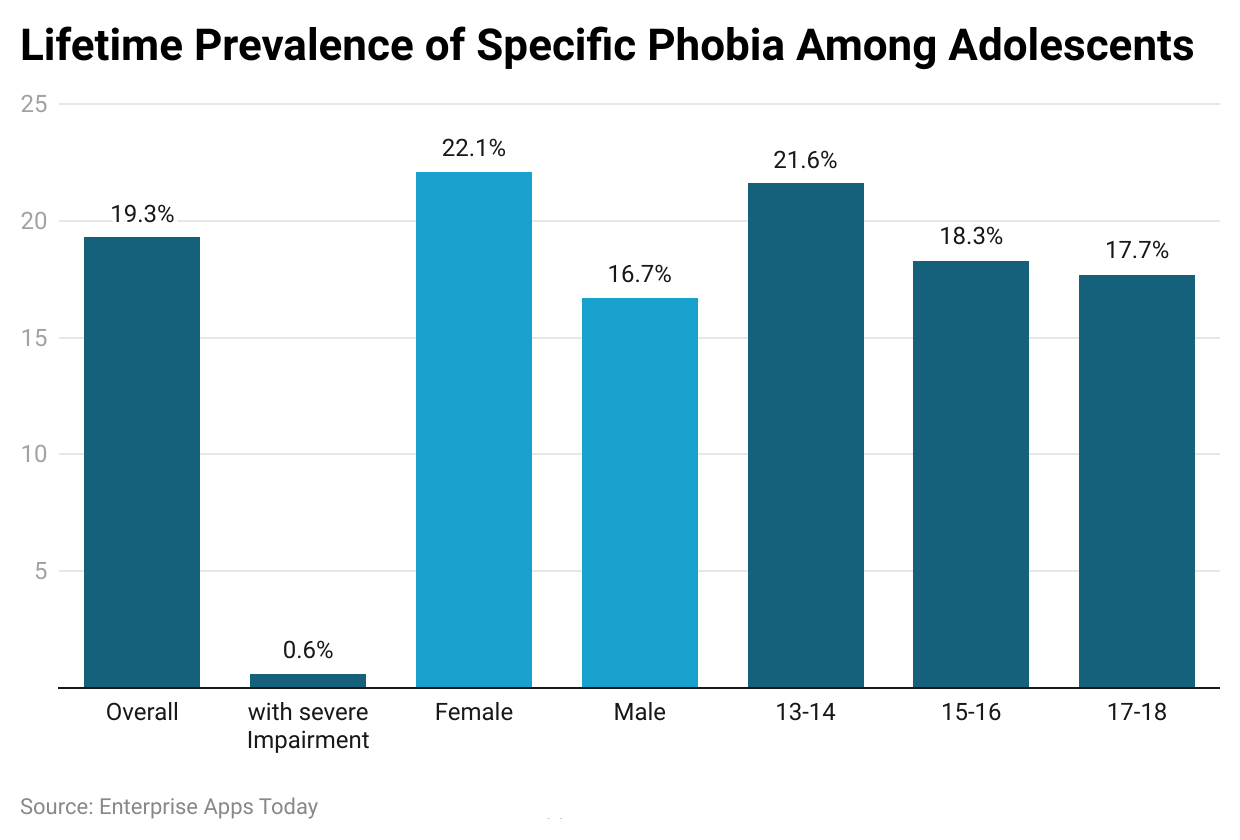
(Source: nimh.nih.gov)
- The recorded lifetime prevalence of specific phobia among adolescents is 19.3%, out of these 0.6% suffer from a severe impairment.
- The lifetime prevalence rate in girls is 22.1% while it is 16.7% in boys.
- Moreover, age-wise Specific Phobia Statistics state that, children aged between 13 to 14 years and 15 to 16 years have a rate of 21.6% and 18.3% respectively.
- And 17.7% is a lifetime prevalence rate in 17 to 18 years aged adolescents.
Conclusion
Concluding the Phobia Statistics, it is clear that, in the United States of America, having a phobia of something is a common mental illness and is more likely found in females than males. It could be diagnosed at an early age or even in old age, but remember, if medications or consultation is made in an early stage it is totally curable. If you feel scared of animals or get afraid when stuck in closed rooms, then you must consult your doctor immediately.
Sources
FAQ.
Phobias occur frequently and can cause extreme effects on the body as well as the mind. Phobias don’t generally go away but fear can go away easily.
Specific phobia and social phobia are two common types found in the majority of individuals in the United States of America.
If your fear of darkness goes away easily and doesn’t occur frequently then it is a type of normal fear, and if darkness creates hypertension or any extreme body movement then you shall consult a doctor as soon as possible.
If you consult your doctor in the early stage, then of course phobias are curable. Some of the cases are severe, and these people fail to recover. If you have any doubt about any specific fear you must consult your doctor immediately.

By conducting scientific research, I write about illness, health and healthcare. As a professional medical writer, my experience includes creating feature articles for newsletters and websites as well as research news stories for doctors and researchers. Reading has been an integral part of me since childhood - I'm fan of "Friends" and the "Harry Potter series". Before this career, I was employed by a French multinational company. However, my passion for reading led me to pursue writing professionally; my first Amazon-published short story entitled "The envelope that changed our lives" has recently been released. In my free moments, I enjoy long bike rides around town.